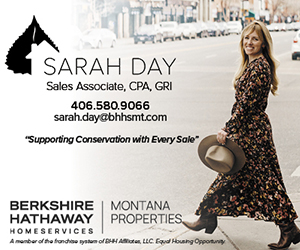Find the Right Horse for a New Way of Life
Growing up in the San Francisco Bay area in the 50's and 60's—before business expanded across the Bay into the suburbs, before the dot.com companies redefined the economy—I wondered where the pavement ended. Even then, you had to drive a long distance before you could see mountains and clear-running streams, horses running across open meadows, or stars so close you felt you could touch them.
Many years later, long into adulthood, I found my way to Montana. Anyone who has transplanted here from a larger metro area knows the feeling: at some point, the Montana landscape both claims you and heals you. Bozeman, where a mix of the artistic, the intellectual, and a life close to the earth has become the haven of many a transplant’s dreams, represents all the best Montana has to offer.
It does, however, take some education to learn how to live here. There are trade-offs to make, myths to be exploded. From expected winter power failures, to understanding that your dog cannot run free on a neighboring ranch, to owning one’s first horse—there is a lot to know.
About that horse. You know the one. It’s the one you got at a local horse sale across town that your good friend told you about. You saw a wonderful display of horsemanship on an animal with terrific conformation and obvious spirit. You were so impressed by the movement, the beauty and majesty of the animal, you made your purchase on the spot and brought her home. You thought you had an experienced animal, one who would be great around kids, who was more settled down than a young horse would be. But you got her home, and suddenly you had a biting, bucking, snorting animal on your hands who only struck fear in your heart.
Or perhaps it was the horse that you saw on a neighboring ranch, and fell in love with—only to find, in your care, that he spooks at the slightest thing, rears when you’re on him, and takes off like a bat out of hell when the inclination strikes.
Lana Serrano knows the feeling all too well: “Our four children consume my life but I needed a friend—just for me. A horse. My husband said there is no way to find a horse who would take care of you until your riding and confidence improves, to go to shows with, trail rides, let the children ride, etc. Horses are mistreated, used and then sold to the unsuspecting. It's just too dangerous out there. I sadly agreed.”
How on earth do you go about finding the right pleasure-riding horse, one that has a little perception, and is also well-disciplined and well trained? Is there a horse out there you can bond with in that magical way that is the stuff of legends?
The answer to the last question is yes—as a matter of fact, that special horse may be looking for you, too. And the answer to the first question is… head out to La Cense. La Cense Montana, an 80,000-acre Quarter Horse and Black Angus ranch just two hours away in Dillon, has taken a whole different approach toward matching horses and people.
La Cense specializes in training young registered Quarter Horses in the Parelli methods of natural horsemanship (developed by acclaimed horseman Pat Parelli), then selling them as recreational horses. Hand-picked from selected breeding farms for their conformation, disposition and spirit, the horse are brought to the ranch as 2-year-olds who have had minimal exposure to human beings. Once at the ranch, they are gradually introduced to the presence, feel and touch of people—and of halters and ropes. During the next 1-2 years, depending upon the needs of the horse, each will learn to bridge the normal boundaries between predator (humans) and prey (horses), and develop trust; they will learn to respond to the slightest of commands instead of the most forceful of commands; and, because they are being raised on a working cattle ranch, they will become used to unexpected sights, sounds and circumstances without spooking or bolting.
And when it comes time to be sold—well, it’s how the horse reacts to the prospective buyer that actually counts more than how the buyer reacts to the horse.
Lana Serrano writes that when she visited the ranch, it was the head trainer who picked out her horse, Carrot. In truth though, the La Cense trainers are more likely to say, “No, it was Carrot who picked out Lana.” The trainers at La Cense look for signals and clues in “horse language” that indicate a horse is responding positively to a human being. As things have turned out, the match between Lana and Carrot is a prime example of what happens when a young horse is taught the principles of trust and harmony, and allowed to help choose its new owner. Lana writes of her amazement and joy:
Just that trip home was unbelievable. He's with new people, riding all day, stopping to stay at unfamiliar facilities, in stalls which he was never in, back in the trailer, every day.... Every single person we met was absolutely amazed that this horse had never done or seen any of this before and had just turned 4 a few days before. Not one hesitation, not one minute of being afraid—nothing. It was as if we had owned him for 20 years.
Our first outing was to take him on a walk around the neighborhood. Down the gravel roads, with barking dogs, cars, houses, children playing and our children riding their bikes in front of and behind him! He wanted to go forever but politely took me home when I asked.
The second day (of a horse clinic a few weeks later) was an especially important one for me. I bought a horse I could only walk and trot on because I was afraid to canter. (I was hurt badly at age 11 —a rental horse at a rental place, the horse decided to go back to the barn, my leg stuck in the stirrup, I was dragged 1/4 mile with only my head and shoulders on the ground). Anyway, I said to Carrot, let’s just canter a few steps —I'll try. And he only did a few steps. I tried again, a few more steps! He takes care of me—he would not go faster than I felt comfortable with—and I only ride him with his natural hackamore. I trust him completely because he earned my trust—even in these few weeks. I never cantered on my other horse, not for the 15 years that I owned him. The other students said they saw the joy in his eyes as if he was saying, “Great, now we can actually go somewhere!"
He's extremely loving and caring. I go out to him at anytime and he comes. I don't have food—I usually have his halter. He's just happy to be with me doing whatever. He is my true partner. A lady at the clinic said, "you don't see this very often, but that horse loves you.” What a thrill to hear that his feelings for me show—and I love him too!
Lana’s words reflect a true partnership; she respects Carrot as much as he respects her. She talks about her horse as being polite, trustworthy, caring; and Carrot’s treatment of Lana indicates he feels the same. The words Lana uses are just shadows in the horse world, where it’s what is not spoken that is communicated.
In fact, one of the first things a visitor to La Cense’s massive indoor arena notices is the silence. There may be 10 or 15 horses and several trainers in different parts of the arena, but the human voice is rarely heard; neither is the crack of a whip nor the jangle of a spur. The La Cense horses just wear a simple halter—no bit or bridle—as they are put through their paces. Each spring, the colt-starting clinic takes the new arrivals and gets them used to the human touch, the feel of a rope, and the feeling of someone’s weight over their bodies. Gradually, they become used to playing Parelli’s 7 “Friendly Games,” and from there, learn more intricate and subtle commands as they progress.
This training goes on for up to two years, or 1000 hours of training, for each of the 75 or so horses that are on the ranch at any given point in time. The La Cense training team, comprised of upper-level Parelli horsemen and women, work with a number of students at the ranch to provide the horses with this critical training in their early years. Some of the students come from La Cense’s sister ranch outside Paris, France, called Haras de la Cense, the first natural horsemanship school in Europe. Students enrolled in its two-year certification program are required to spend a year of that time on the ranch in Montana.
The European students are joined by American students who are at the ranch to attend various upper-level clinics and professional development workshops. All students continue the emphasis on trust and harmony, building a sound partnership with each horse. As a result, the La Cense horses quickly become the “miracle” horses who cause people like Lana Serrano to respond with such enthusiasm.
The lessons taught by the horses are similar to the lessons the Gallatin Valley and its surrounding peaks teach the newcomer. The landscape waits to claim us and heal us, a feeling every Montanan knows. So, too, do the horses. They wait to find the right person to carry along the trails under the Big Sky.
Sidebar
When a buyer is interested in purchasing a La Cense horse, he or she quickly learns that these are not products being sold off a shelf. The prospective buyer first calls the ranch for a long telephone interview with a member of the training team. They will discuss the prospective buyer's background, interest, experience, and intentions in owning a horse—the same kind of conversation Lana Serrano had when she first called the ranch.
The next step is to visit the ranch, and to meet the training team in person. A more in-depth interview follows, and after some discussion, buyer and trainer will head down to the indoor arena where several horses are selected to review. Perhaps several of the horses will be chosen to take out on a trail ride, switching horses along the route to see how the buyer and each horse get along and respond to each other. The La Cense trainers will be watching the responses of the horses as well as the responses of the buyer. The ideal match-up is a horse that will bring out the best in a human being. With their heightened powers of perception, the horses will most likely know who they can work with before the humans do.
If the prospective new owner is inexperienced, training in natural horsemanship is available at the ranch. The La Cense team will also recommend a Parelli trainer nearest to the buyer’s home. Many times, as in Lana Serrano’s case, the new owner will actually know less than the horse. Lana is considered a Level I Parelli rider, while Carrot is a Level 3 Parelli horse. Lana writes that Carrot is always “thrilled when I finally get it right!”
Riders who are more experienced are equally glad to have a highly educated horse with no bad habits or unruly discipline to overcome. That’s the kind of horse the people at La Cense Montana are proud to develop and to offer to the riding public.
To find out more about La Cense Montana, visit lacensemontana.com or call (406) 683-8777.












